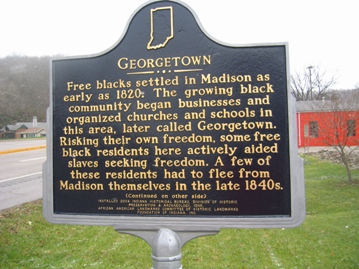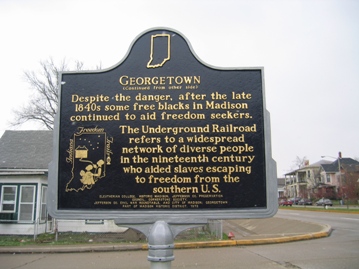

Location: Jefferson & Fifth Streets, Madison. ( Jefferson County, Indiana)
Installed: 2004 Indiana Historical Bureau, Division of Historic Preservation & Archaeology, IDNR, African American Landmarks Committee of Historic Landmarks Foundation of Indiana, Inc., Eleutherian College, Historic Madison, Jefferson Co. Preservation Council, Cornerstone Society, Jefferson Co. Civil War Roundtable, and City of Madison; Georgetown part of Madison Historic District, 1973
ID# : 39.2004.4
Text
Side one:
Free blacks settled in Madison as early as 1820. The growing black community began businesses and organized churches and schools in this area, later called Georgetown. Risking their own freedom, some free black residents here actively aided slaves seeking freedom. A few of these residents had to flee from Madison themselves in the late 1840s.
Side two:
Despite the danger, after the late 1840s some free blacks in Madison continued to aid freedom seekers. The Underground Railroad refers to a widespread network of diverse people in the nineteenth century who aided slaves escaping to freedom from the southern U.S.
Keywords
Underground Railroad , African American , Historic District, Neighborhoods, and Towns
Annotated Text
Free blacks settled in Madison as early as 1820.(2) The growing black community began businesses and organized churches and schools in this area, later called Georgetown.(3) Risking their own freedom, some free black residents here actively aided slaves seeking freedom.(4) A few of these residents had to flee from Madison themselves in the late 1840s.(5)
Despite the danger, after the late 1840s some free blacks in Madison continued to aid freedom seekers.(6) The Underground Railroad refers to a widespread network of diverse people in the nineteenth century who aided slaves escaping to freedom from the southern U.S.
Notes:
(1) Georgetown is included in the Madison Historic District, listed in the National Register of Historic Places 1973.
(2) Donald Zimmer, Madison, Indiana, 1811-1860: A Study in the Process of City Building (Ph.D. dissertation, Indiana University, 1974), p. 62, based on Francis A. Walker, The Statistics of the Population of the United States (Washington, D.C., 1872), p. 126.
(3) Zimmer, pp. 62-64, based on Walker, Statistics, p. 126; U.S. Bureau of Census, Population, City of Madison, Jefferson County Indiana, 1850, microfilm or internet, lists black citizens with trades and employment. For Georgetown school and churches, see Williams' Madison Directory, 1859-60, lists, pp. 14-15; Madison Daily Courier, July 29, 1854; and Madison City Census Book, Gm 02 (Jefferson County Historical Society), p. 26. The Madison Daily Courier, August 23, 1853 indicates there was a black Masonic lodge. By 1860, the largest concentration of black population in Madison lived in this area called Georgetown. Zimmer, pp. 60, 62-64, based on Walker, Statistics, p. 126; Zimmer map (p. 60) based on 1860 census and Williams' Madison Directory, indicates where the majority of the black population lived at that time.
Williams' Madison Directory, p.14, has an entry for "Georgetown School, Ellen P. Siddall, Teacher." A Reminiscence by Mary C. Johnson in the Madison Courier, November 6, 1916 talks about Georgetown.
(4) Four of the best documented men are included here.
George De Baptiste: 1840 Census, City of Madison; land purchase September 18, 1838, Jefferson County Deed Book V, pp. 267-68; land sold 1846, Jefferson County Deed Book I, pp. 75-76; Supplement, Detroit Post, May 14, 1870; Michigan Chronicle, March 10, 1973; Michigan Chronicle, December 13, 1975; Madison Evening Courier, January 13, 1880; John H. Tibbets, Reminiscences of Slavery Times, pp. 3, 9.
Elijah Anderson: 1840 Census; Tibbets, pp. 9, 10, 11, 13 (Note that date of 1858 relating to Elijah Anderson on p. 13 is not correct. Anderson was sentenced to the Kentucky State Penitentiary for 8 years and 8 months sometime before June 20, 1857. Madison Daily Courier, June 20, 1857; see also, Madison Evening Courier, June 15, 1874.); Madison Evening Courier, January 13, 1880; James M. Prichard, Into the Fiery Furnace: Anti-Slavery Prisoners in the Kentucky State Penitentiary, 1844-1870, Part 2 (accessed February 24, 2004).
John Carter: I840 and 1850 Census; land purchase November 29, 1838, Jefferson County Deed Book V, pp. 279-81; land purchase, February 1, 1840, Jefferson County Deed Book R, pp. 281-282; Tibbets, pp. 7, 9; Edwards' Annual Director . . . City of Madison for 1867 (St. Louis: Edwards, Greenough & Deved, 1867), p. 193; Williams' Madison Directory; Madison Evening Courier, January 13, 1880.
William J. Anderson: William J. Anderson, Life and Narrative of William J. Anderson (Chicago, 1857), p. 35 (electronic edition, at ); Anderson is not listed in the Census until 1850 and 1860; purchased land 1845, Jefferson County Deed Book W, pp. 285-86; sold land 1852, Jefferson County Deed Book 1852, pp. 63-64; Madison Daily Courier, March 18, 1867; Madison Evening Courier, January 13, 1880.
NOTE: Locations of the homes and businesses of some of these individuals are listed in Diane Perrine Coon, Southeastern Indiana's Underground Railroad Routes and Operations (Indianapolis: Indiana Department of Natural Resources, Division of Historic Preservation and Archaeology, 2001), pp. 57-58. Applicant has included images and identifications of some of the property remaining today. No attempt has been made to verify Coon's information.
(5) George De Baptiste moved to Detroit in 1846. Supplement, Detroit Post, May 14, 1870; Michigan Chronicle, March 10, 1973; Michigan Chronicle, December 13, 1975.
Griffin Booth, according to his obituary, moved to Canada in 1848. He is, however, listed as a resident of Madison in the Jefferson County Indiana Census for 1850. Booth reportedly was rescued from a mob trying to drown him to force him to divulge the location of fleeing slaves. Obituary, Madison Courier, July 5, 1889.
Elijah Anderson: Listed in 1850 Census, Dearborn County, Indiana; Tibbets, pp. 9, 10, 11, 13. (Note that the date of 1858 relating to Elijah Anderson on p. 13 is not correct. Anderson was sentenced to the Kentucky State Penitentiary for 8 years and 8 months sometime before June 20, 1857. Madison Daily Courier, June 20, 1857; see also, Madison Evening Courier, June 15, 1874.)
(6) Tibbet's Reminiscences, p. [13]; Madison Evening Courier, January 13, 1880; Anderson, Life and Narrative, pp. 39, 53-56; Madison Evening Courier, June 15, 1874.
From 1850 to 1860, the black population of Madison decreased from 298 to 247. Zimmer, p. 63. Black populations decreased because of the Fugitive Slave Law of 1850 and Article 13 of the 1851 Indiana Constitution prohibiting blacks from entering Indiana. Emma Lou Thornbrough, The Negro in Indiana: A Study of a Minority (Indianapolis: Indiana Historical Bureau, 1957), pp. 53-54, 99-100.
